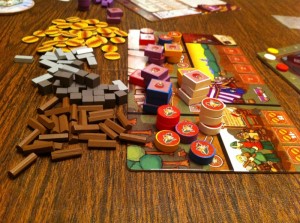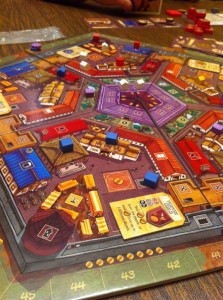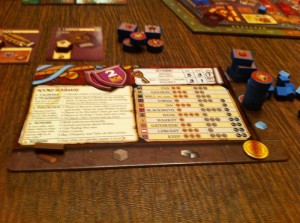 It’s hard for people to remember certain games when so many are being released these days. A blizzard of cubes, mechanisms, and player boards can blow by in the form of ten different games. Some players need a reminder of the theme or core mechanism just to get a sense of whether a game was something they enjoyed. So the central question for Belfort, a game from Tasty Minstrel Games and designers Jay Cormier & Sen-Foong Lim, is “Will players remember Belfort?”
It’s hard for people to remember certain games when so many are being released these days. A blizzard of cubes, mechanisms, and player boards can blow by in the form of ten different games. Some players need a reminder of the theme or core mechanism just to get a sense of whether a game was something they enjoyed. So the central question for Belfort, a game from Tasty Minstrel Games and designers Jay Cormier & Sen-Foong Lim, is “Will players remember Belfort?”
Belfort is a worker placement game for 2-5 players that takes about 90-120 minutes to play. Belfort plays best with 4 players.
Gameplay Overview:
After some basic setup of components and the main board, each of the seven rounds of a game of Belfort proceeds through a series of phases (listed below in sequence) based on actions the players will take.
Calendar – The round marker is advanced.
Placement – Players take turns placing workers (elves and dwarves) on action spaces on the main board (some with a money cost as well) or on resource collection spaces on a side board. Action spaces act as blocking spaces, while resource collection spaces offer a bonus to the player who placed the most workers. Players can also place a worker to change turn order or gain more workers.

Collection – Players retrieve workers as well as resources of wood, stone, metal, and gold. In this step, turn order is changed and extra workers are acquired. At the end of this step, players must also pay taxes according to their position on the victory point track (higher position = higher taxes).
Actions – This is the heart of much of the strategy in the game. Players can take the actions of their workers placed on the main board, as well as construct buildings from cards held in hand. If players don’t have enough of a certain resource, they can visit the Trading Post for resource conversion or purchase. Players can also buy Gnome workers during this phase which “unlock” the abilities of certain buildings or purchase some of the action spaces on the main board with the attempt at gaining extra income.
As soon as a player does not wish to complete any more buildings (or cannot complete any more), their Action phase is over.
Scoring – On the 3rd, 5th, and 7th rounds, players score points in area majority style (most buildings owned) for each of the five sections of the city and for majority of types of workers.
After a completion of seven rounds, the game ends and ties are broken by most resources.
Game Experience:

When wondering whether Belfort is memorable, the clearest case is evident from the component quality, on through the rules, and then directly into the gameplay. The entertaining decor is enhanced by the meat of this game and what players walk away from are mental retreads over mis-steps in play and celebrations of a crucial wave of building. These are the memories of Belfort.
Some of these memories stem from the intense strategic choices available. The variable worker placement spaces on the main board change from game to game and can alter play dramatically. There’s also variety in the kinds of building cards available which determine a certain path to a player’s building decisions. These layers and the area control point structure confine players somewhat, but they make the construction of each building a deep decision.
Although it has already been mentioned, the focus of the imagery and visual design is also crucial to how the game feels. The caricatures of gnomes, dwarves, and elves have a childlike aesthetic. The illustrations on the board add to the scene, but rarely is graphic design clarity sacrificed. The humor smacks of British irreverence and pessimistic expectations of bureaucracy, something many gamers are familiar with.

Players might also feel like there are some elements that disrupt their own expectations. The taxation mechanism, which keeps players from succeeding too fast works really well, but players comfortable with catch-up mechanisms from other games may find it bothersome. Another aspect of frustration can also be found in the card draws for buildings. Even though players share this randomness, a player who can’t get the right building to gain majority in a sector of the board might feel success is more arbitrary.
Final Thoughts:
Belfort is a wonderful game. The tension and strategic decisions are palpable from the first worker placed. Fans of area control and resource management games can easily come together in agreement on this title. The niggling randomness in the selection for building cards can distract some players, but it doesn’t detract from wanting to pull this game off the shelf regularly. The art and humorous tone are garnishes to the underlying engaging gameplay. The answer to the question at the beginning of this article is “Yes, players will remember Belfort”.
If you’d like to get a copy of Belfort, it’s currently out of print, so you’ll need to head to the secondary market.
Final Score: 4 Stars – While hitting the high notes of area control, worker placement, and resource management, small issues with card randomness still left little to be desired.
 Hits:
Hits:
• Area control tension
• Whimsical art and theme
• Taxation, leader slow down mechanism
Misses:
• Building card randomness
• Not so great with two players























I love this game on the whole, but it does the one thing I absolutely hate when it comes to two player rules. If a game requires a dummy player to work with two players, then it’s not a two player game.